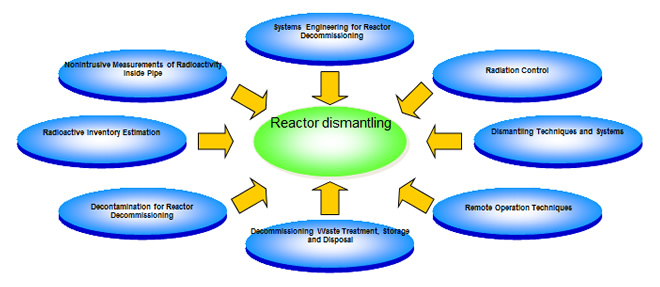Reactor Decommissioning Technology Development(JPDR)
Various techniques were needed to demolish reactors, taking into consideration the protection of workers against radiation exposure. Before and during the JPDR decommissioning, research and development of the following eight techniques were systematically performed by the JAEA.

Systems Engineering for Reactor Decommissioning
To accomplish reactor decommissioning safely and economically, it is necessary to analyze the work needed and to select the most favorable techniques and procedures. The following data related to the decommissioning process must be evaluated: worker exposure, the amount and type of radioactive waste, labor cost, necessary equipment and materials, etc. A computer code was developed for evaluating this data efficiently. The evaluation results of this code were used in the management of the JPDR decommissioning work.
Radiation Control
Various devices and techniques were developed to establish radiation control technology for reducing radiation exposure to workers and for improving work efficiency in reactor dismantling.
●Contamination Monitors
●Remote High Dose-Rate Measuring Instrumentation
●Respirable Dust Monitors
●Scanners for Extremely Low-Level Waste
●Contamination and Dose-Rate Monitors for Waste Packages
●Environmental Impact Assessment for Radioactivity Discharge
Dismantling Techniques and Systems
Appropriate dismantling techniques and systems for each reactor component and structure were developed to efficiently and safely dismantle steel and concrete structures that were activated and/or contaminated. The following dismantling systems were used for the JPDR dismantlement project.
For Steel Structures
For Concrete Structures
Remote Operation Techniques
Remote operation was vital for dismantling work conducted in a high-level radiation environment to reduce radiation exposure of workers. The following research and development activities were conducted to accomplish this.
●Research of Remote Control Technology
●Testing of Radiation-Resistant Sensors for Remotely Operated Systems
●Fabrication and Testing of Robotic Manipulator Systems
Decommissioning Waste Treatment, Storage, and Disposal
The following techniques were developed for treatment, storage, and disposal of very large volumes of waste generated from dismantling of the reactor facility.
●Containers for Waste
●Volume Reduction and Segregation of Waste
●Cement Solidification of Crushed Concrete Waste
●Immobilization of Surface Contamination on Dismantled Components
Decontamination for Reactor Decommissioning
The following decontamination techniques for reactor decommissioning were developed to minimize the radiation exposure of workers and to reduce the quantity of radioactive waste.
●Decontamination of the System before Dismantling
●Decontamination of Dismantled Components
●Concrete Surface Decontamination
Radioactive Inventory Estimation
An accurate estimate of radioactive inventory in a reactor facility at the end of its life is essential and fundamental towards the preparation of its decommissioning plan. For this reason, methods to identify radionuclides and to measure their distributions were extensively evaluated throughout the JPDR facility. These measurements and calculations were used to prepare a rational dismantling plan for the JPDR.
Nonintrusive Measurements of Radioactivity inside Piping
To cut pipes safely and efficiently, it is important to evaluate their radioactive inventory, namely the contained radionuclides and their distribution, inside the pipes in advance. As a result, an in situ, nonintrusive measurement system for the measurement of radioactivity inside of piping was developed.







